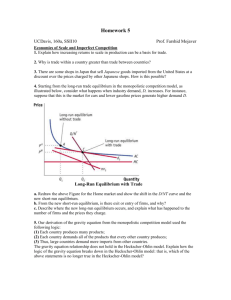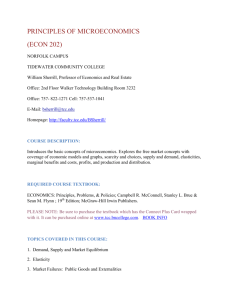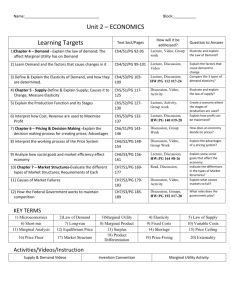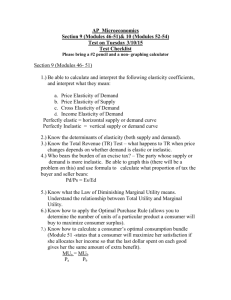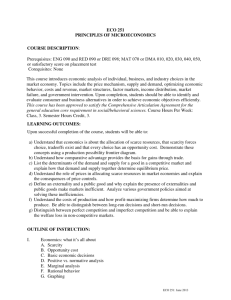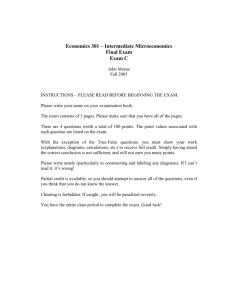division - Lake Land College
advertisement
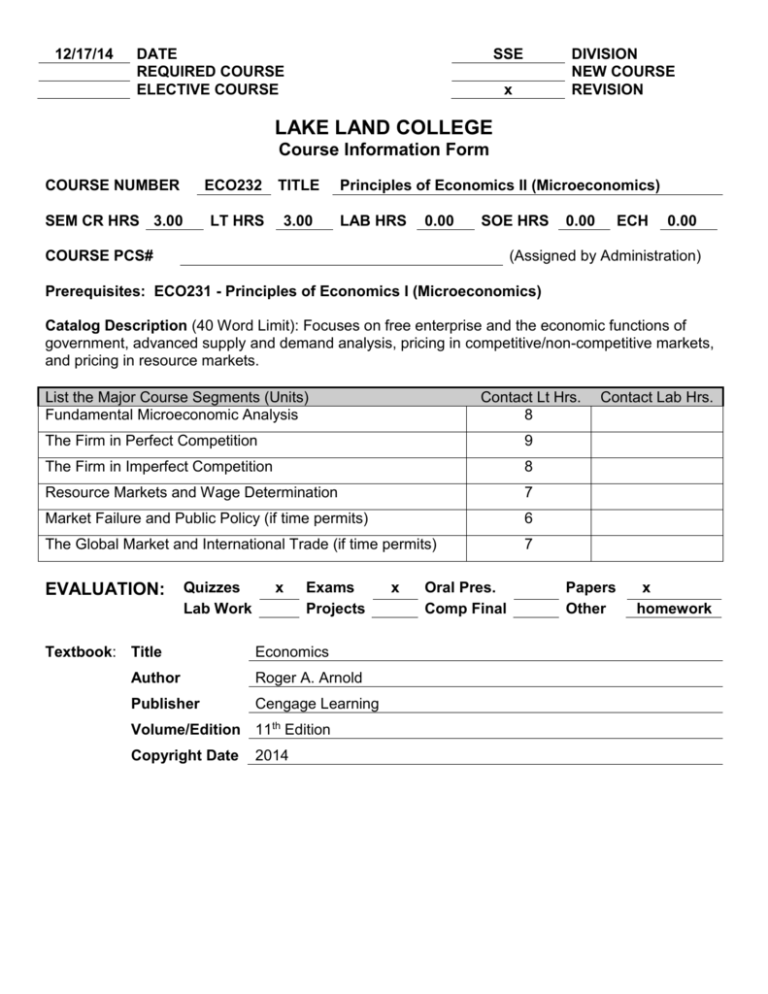
12/17/14 DATE REQUIRED COURSE ELECTIVE COURSE SSE DIVISION NEW COURSE REVISION x LAKE LAND COLLEGE Course Information Form COURSE NUMBER ECO232 TITLE SEM CR HRS 3.00 LT HRS 3.00 Principles of Economics II (Microeconomics) LAB HRS 0.00 SOE HRS COURSE PCS# 0.00 ECH 0.00 (Assigned by Administration) Prerequisites: ECO231 - Principles of Economics I (Microeconomics) Catalog Description (40 Word Limit): Focuses on free enterprise and the economic functions of government, advanced supply and demand analysis, pricing in competitive/non-competitive markets, and pricing in resource markets. List the Major Course Segments (Units) Fundamental Microeconomic Analysis Contact Lt Hrs. 8 The Firm in Perfect Competition 9 The Firm in Imperfect Competition 8 Resource Markets and Wage Determination 7 Market Failure and Public Policy (if time permits) 6 The Global Market and International Trade (if time permits) 7 EVALUATION: Quizzes Lab Work Textbook: Title x Exams Projects Economics Author Roger A. Arnold Publisher Cengage Learning Volume/Edition 11th Edition Copyright Date 2014 x Oral Pres. Comp Final Contact Lab Hrs. Papers Other x homework Major Course Segment UNIT ONE: FUNDAMENTAL MICROECONOMIC ANALYSIS Advanced Supply and Demand Analysis Define and explain the Law of Demand; changes quantity demanded vs. changes in demand Determinants of Demand Define and explain the Law of Supply; changes in quantity supplies vs. changes in supply; Determinants of Supply Explain the determination of equilibrium and explain the equilibrating forces in the market Define and explain government imposed price ceilings and floors and their effect on the rationing function of prices Elasticity of Supply and Demand Calculate elasticity coefficients and determine elastic, inelastic and unitary product demand Explain the effects of differing elasticities on total revenue Define and explain the determinants of elasticity of supply and demand Utility Analysis Calculate total and marginal utility and explain the law of diminishing marginal utility Define and explain the conditions for consumer equilibrium and derive the demand curve for a product using utility analysis Discuss consumer surplus and the relationship of utility analysis to the Law of Demand Hours Learning Outcomes Student will be able to: Students will be able to describe the impact of global or domestic changes on individual markets for goods and/or services. 1 1 1 1 1 Students will be familiar with the concepts of elasticity and be able to apply this concept to various markets. 1 1 1 1 1 1 UNIT TWO: THE FIRM IN PERFECT COMPETITION Cost and Production in the Firm Define and calculate costs and profits; economic, implicit, explicit, accounting and normal. Discuss and explain the types of resources and determination of short-run and long-run periods Calculate and graph firm's costs: average, total and marginal Construct and evaluate the long-run average cost curve using economies and diseconomies of scale The Perfectly Competitive Firm Explain the basic characteristics of perfect competition - derive individual demand curve Calculate and graph average, total and marginal revenue Explain output determination using the two cost approaches Explain and graph long-run equilibrium and discuss constant, increasing and decreasing cost industries. Define and explain the requirements for efficiency UNIT THREE: THE FIRM IN IMPERFECT COMPETITION Monopoly Define basic characteristics with special emphasis on barriers to entry. Construct and evaluate demand, marginal revenue and average revenue to the monopolist Explain and graph output determination requirements and long-run equilibrium The student will be able to recognize and describe the four different market structures: Perfect Competition, Monopolistic Competition, Oligopoly and Monopoly. 1 1 1 1 .5 1 Evaluate economic efficiency in monopoly and explain the concepts of deadweight loss and price discrimination Discuss how anti-trust laws address monopolistic behavior by firms. Monopolistic Competition Define basic characteristics. Construct demand curve, marginal revenue and explain output determination Discuss long-run equilibrium and economic efficiency under monopolistic competition Discuss the issue of choice vs. number of firms producing similar products Oligopoly Define basic characteristics Evaluate and explain the kinked demand curve/price rigidity model Evaluate the cartel model and explain how output is determined. Discuss the problems with maintaining a cartel Discuss the types of illegality under which collusive behavior of varying types falls UNIT FOUR: RESOURCE MARKETS AND LABOR SUPPLY AND DEMAND Regulation, Deregulation and Antitrust Policy Differentiate between social and economic regulation Discuss the evolution of antitrust law. List and explain the major antitrust laws and why they were passed Discuss arguments for and against deregulation Externalities and the Environment Define the theory of renewable resources – economic growth and increasing negative 1 1 1 1 1 1 1 1 externalities (discuss) Evaluate the Cost Analysis of externalities Discuss environmental protection policies UNIT FIVE: THE GLOBAL MARKET AND INTERNATIONAL TRADE International Trade Gains from trade -- discuss comparative advantage and production possibilities Explain the role of world price on trading in the world market Discuss the effect of trade on social welfare Explain different types of trade restrictions and NAFTA Discuss the arguments presented supporting trade restrictions Evaluate the possible problems of enforcing trade restrictions. 1 1 1 1 1 1 1 1 Course Outcomes: At the conclusion of this course the student is expected to: 1. 2. 3. 4. 5. 6. 7. 8. Locate information Evaluate sources Analyze data and arguments Interpret initial results Transfer insights to new contexts Perform mathematical operations Interpret tables and graphs Understand multiple economic, geographical, or historical perspectives THE FOLLOWING GENERAL EDUCATION GOALS ARE MET IN THIS COURSE: Critical Thinking: Students are required to identify real life examples of the economic principles taught in class. This requires students to take knowledge that is theoretical in nature and then use this information to analyze real life events. Problem Solving: Students will use graphs to illustrate many different economic principles. In doing so, students will become proficient in drawing and interpreting two-variable graphs. Students will also be required to perform mathematical operations and use percentages throughout the semester. Diversity: Students are exposed to several different schools of economic thought. Through this, students will see how it is possible to reach a variety of conclusions depending on your economic perspective.




